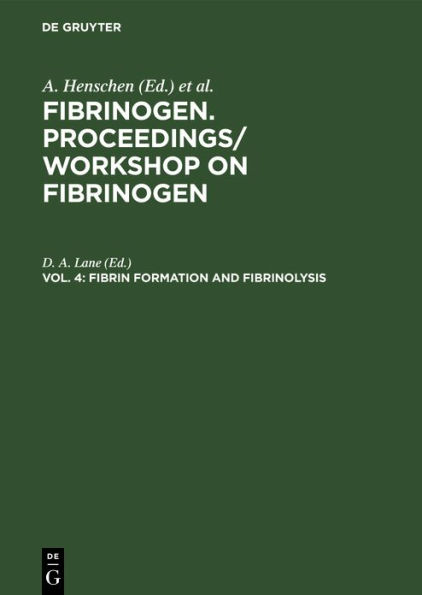Table of Contents
Frontmatter — Preface — Contributors — Contents — I. Synthesis And Assembly — A scheme for the intracellular assembly of human fibrinogen — Evidence that platelet and plasma fibrinogen have the same A-alpha chain gene product — Fibrinopeptide A and the phosphorylation of fibrinogen — II. Structure and Function — Size and shape of the fibrinogen molecule: crystalline forms of native and modified human fibrinogen — The C-terminal polymerisation domain of fibrinogen — δ- Chain Crosslinking Of Fibrin At Dd-Trans Contact — Soluble fibrin contains fibrin polymers of different molecular weight. Ultracentrifugation studies at 37°C — Relationship of final thickness of fibrin fibers to maximal rate of assembly and to fibrinopeptide B release — III. Congenital Variants — Fibrinogen New York 1: The structural, functional, and genetic defects and an hypothesis of the role of fibrin in the regulation of coagulation and fibrinolysis — Fibrinogen Pontoise - a genetically abnormal fibrinogen with defective fibrin polymerisation but normal fibrinopeptide release — Fibrinogen Milano I: Abnormal fibrin polymerization related to a carboxy-terrainal defect of the δ-chain (δ-330 Asp Val) — Fibrinogen "Bergamo I" (?? 16 Arg - Cys): Alternative methods for structure elucidation — Screening small plasma samples by HPLC for abnormalities of fibrinopeptide release — Iv. Fibrin(ogen) And Fibrinolysis — On the role of fibrin in the fibrinolytic system — Isolation and characterisation of plasmic degradation products of fibrinogen by high-performance liquid chromatography — The acceleration of tissue-type plasminogen activator (t-PA)-mediated activation of plasminogen by fibrinogen cyanogen bromide fragments is species specific — Role of fibrin polymerization in fibrinolysis: Comparison between polymerisable and unpolymerisable fibrins in the potentiating effect of plasminogen activation by tissue-type plasminogen activator (tpA) — Role of fibrin and its degradation products in the activation of plasminogen by streptokinase and urokinase — V. Interactions With Cells — The role of fibrinogen in platelet aggregation — Platelet-associated fibrinogen: Conformational change of fibrinogen induced by its adsorption to platelet-surface — Migration of cultured endothelial cells in response to fibrinogen — Characteristics of the interactions of fibrinogen and soluble fibrin with cultured endothelial cells — Mechanism of fibrin-induced disorganisation of cultured human endothelial cells — The fibrinogen: red cell interaction and its influence on blood rheology — Haemorheologic effects of plasmin and thrombininduced fibrinogen derivatives: An in vitro study — Binding of human fibrinogen to streptococci and its role in streptococcal pathogenicity — VI. Assays To Fibrin(ogen) Fragments And Their Use — Discrimination between fibrin and fibrinogen by a monoclonal antibody against a synthetic hexapeptide representing the amino-terminus of the alpha-chain of fibrin — A new enzyme immunoassay of fibrin(ogen) degradation products in plasma using a monoclonal antibody — Fibrin(ogen) degradation products. Determination using a monoclonal anti D neo antibody. Advantages in clinical investigation — A monoclonal antibody, specific for human fibrinogen and fibrinopeptide A-containing fragments. Its application in an enzyme-immunoassay for fibrinogen degradation products, suitable for use in plasma — A monoclonal antibody against the CNBr-peptide F-CB3 of the Aδ-chain of human fibrinogen — Clinical aspects of fibrin formation and fibrinolysis measured with monoclonal antibodies against D-dimer — Fibrinogen derivatives in acute stroke — VII. Fibrin(ogen) And Disease Pathology — Triggering of the extrinsic blood coagulation system — Extravascular fibrin formation and fibrinolysis in a model of inflammation accompanying cellular hypersensitivity — Extra-vascular fibrin deposition in cellular hypersensitivity - the role of T lymphocyte-macrop




